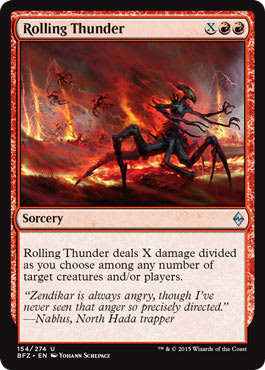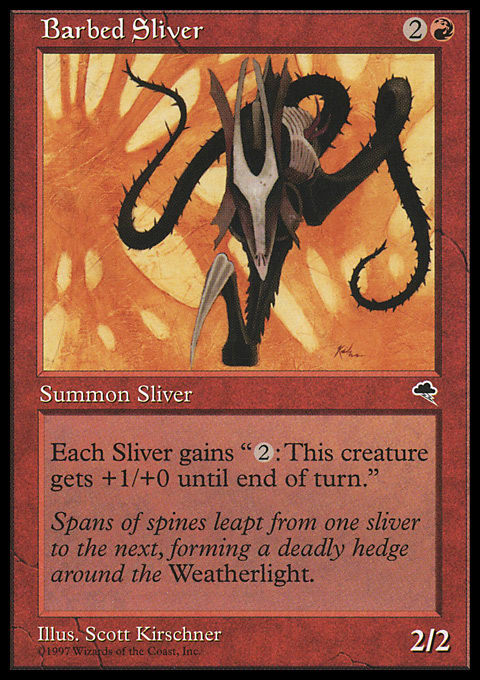Tempest was the first set that spoke to me.
I remember opening up a copy of The Duelist I had received in the mail and seeing the advertisement: the Skyship Weatherlight set against the dark clouds of a world that was distinctly alien, while being comprised of known parts. Rath, as I would come to know it, was like a medieval castle built entirely out of pieces from Lego Space. I looked to the next page and saw Barbed Sliver, and I was immediately snagged, trapped in my interest for this new set.
On New Year’s Day in 1998, I went to Neutral Ground to play in a Tempest only Sealed tournament. I didn’t have school and figured that would be as good a way as any to spend the day. Many years later, I returned for a Tempest-block flashback Draft with a twist: Korean packs of Exodus. I managed to do quite well thanks to my duo of Rolling Thunder and Scalding Salamander.
I bought a box of Exodus, and in it, I opened enough copies of Hatred to build a passable aggressive black deck. I played that deck as much as I could across Standard and Extended—even when it was not the right choice.
My own history with Magic is inextricably tied to the Tempest block. The pre-apocalyptic world with a shifting landscape was unique and was a stark contrast to the sun-soaked world of Mirage. While I had liked Magic before, Tempest tilted the scales toward true love.
So when I heard about Tempest Remastered, I smiled. I have become a much better player since the set was originally released, and my involvement with the game today is so very different than it was seventeen years ago. I can’t wait to experience an old format for the first time, all over again.
And yet, Tempest Remastered interests me on an entirely different plane as well. The entire concept of taking existing cards to create a new Draft environment should ring very true to people who develop and curate Cubes. While many are exposed to the concept of Cube through Magic Online and the program’s Legacy and Holiday variants, loaded with good stuff, there are as many ways to build a Cube as to skin a cat. (Disclaimer: Alex does not support animal cruelty. Laziness in writing, however, gets his vote.) While the Tempest Remastered will not be singleton, it still represents a Draft environment curated from an unalterable set of cards—if Ian Duke and Adam Prosak wanted Trained Armodon to cost ![]()
![]() instead of
instead of ![]()
![]()
![]() , they were stuck. It is this restriction that sings to my inner designer. Sam Stoddard put it best:
, they were stuck. It is this restriction that sings to my inner designer. Sam Stoddard put it best:
I am going to start at the end of Stoddard’s article “Remastering Tempest” because, as with all great essays, the killer stuff comes at the close. Sam spends a good amount of time discussing how they tried to capture the feel of Tempest Limited while still balancing it for the modern age. This was a monumental task.
Tempest came before a unified age of design. Unlike Innistrad and Theros, there has been no indication that Tempest tried to use its gameplay to evoke specific emotions. Innistrad was about the tension of gothic horror, and Theros played toward heroic accomplishment. Tempest, however, was a story about the unknown. In a very Vorthosian sense, it was about braving the wilds to rescue a friend. While there were greater story implications to come, Tempest is tale of the strength of emotional bonds in the face of overwhelming odds.
How can this be communicated through gameplay?
Tempest Limited was fast. We’re talking Zendikar speed. Due in no small part to creatures featuring shadow, games taking place on Rath could end rather quickly. Combine the abundance of strong removal sharing colors with the shadow creatures, and games could end in the blink of an eye. Judging from the spoiler, some of this speed has been retained, but it has moved to higher rarity. However, the threat of the unknown still looms.
To me, this is a success of the development team. Keeping shadow as well as key cards like Rolling Thunder creates a sense of impending doom. Rath represents a twisted mirror of typical fantasy in many ways and the idea of that the darkness being pierced with a strike of lightning to end your day remains.
Extrapolating to Cube curation, we can see the importance of feel. Tempest Remastered had to apply modern sensibilities to a set almost two decades old and use existing elements to convey a similar, holistic experience. From here, it makes sense to conclude that one way to approach Cube design is experience first. What is it that your particular Cube is trying to convey? Are you looking to have it be the greatest hits from Magic’s lush history or are you trying to capture the trope of humans fighting an undead horde? Focusing on feel gives great insight into so-called “block Cubes,” which try to cultivate from a linked pool of cards. Taking it to one extreme, it could mean including the correct green card with bolster in a Ravnica-blocks Cube to help with cards that care about +1/+1 counters in Golgari, Gruul, and Simic. Of course, this would go against the “feeling” from the flavor and trend toward the feeling of the gameplay. There is no right answer—the Curator is able to decide what is correct for his or her particular Cube.
On removal, Sam Stoddard had this to say:
The volume of removal in a Cube is something I have previously explored. Stoddard’s quote here, however, made me rethink my own beliefs. Working exclusively with an all-commons Cube has skewed my perspective of the nature of removal. A simple line of text has given me a new lens.
What matters is not only the frequency of removal, but also its relative strength. In many ways, this is why Shock was so important in Onslaught Draft: It killed face-down creatures with ease. For Cube designers, the lesson to be learned is all at once simple and complex: Have removal that enhances gameplay.
In my Cube, there is only one Lightning Bolt. The nature of singleton means that this truth is obvious. However, I also included Searing Spear, Lightning Strike, and Incinerate. Is this correct? The above listed quote makes me reconsider. Should the best removal appear less frequently than its less powerful cousin? Should these pastiches of the red boon be Shock variants instead? Here, the answer resides in the play of the games. If creatures are dying too often, maybe it is time to think more about the content of the kill spells than the sheer number. The best results would come from data-mining: seeing how the various removal spells match up against the creatures that populate the mana curve and ensuring that the creatures have a fighting shot against all but the super-premium stuff. That is, of course, if gameplay dictates.
Finally, Sam Stoddard addresses colored mana requirements. As for that Trained Armodon bit from before, it is the same example that the author of Latest Developments used to illustrate this point. While it should be obvious it bears repeating, the focusing on the mana curve is not the end of caring about casting costs. Figuring out when players are going to be able to cast your spells matters almost as much, and that means paying attention to the number of colored mana symbols in the upper-right-hand corner. The volume here can have long-standing ramifications, including what colors act as bases for Draft decks and which achieve their greatness when seen as a secondary color. Understanding when different spells fall on the actual curve as opposed to an ideal curve also can influence the number of smoothing mechanics featured in your Cube.
Cube curation is equal parts art and science, and when a developer from Wizards of the Coast speaks, curators should stop and listen. While we all love this game, it is their profession to make it the best possible experience. We have passion—they have it and more resources than an amatuer. Articles such as “Remastering Tempest” are valuable because they provide insight into the base levels of what goes into making something interesting for Limited play. And in the end, isn’t that why we Cube? “Remastering Tempest” doesn’t just make me fourteen again and remembering my first encounter with Moggs and Thalakos—it makes the thirty-one-year-old Alex appreciate the elegance of design.




























